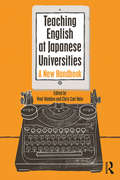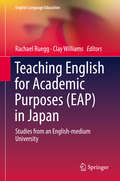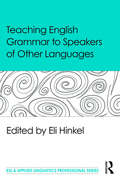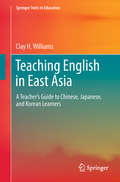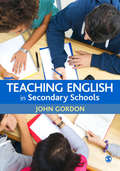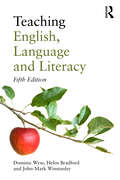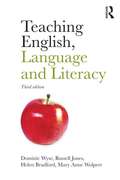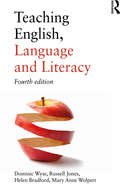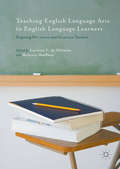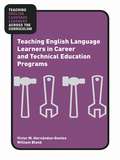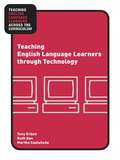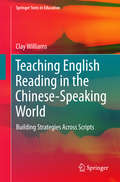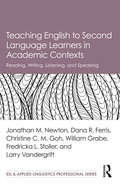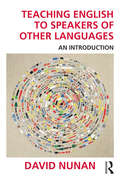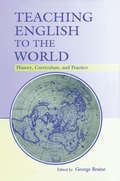- Table View
- List View
Teaching English at Japanese Universities: A New Handbook
by Paul Wadden Chris Carl HaleWritten by leading English-language educators in Japan, this Handbook provides an in-depth guide for the new generation of teachers at Japanese universities. In clear, accessible prose, it offers practical and detailed advice on effective classroom pedagogy, student motivation, learning styles, classroom culture, national language policy, career opportunities, departmental politics, administrative mindset, and institutional identity. Its four sections—The setting, The courses, The classroom, and The workplace—examine issues faced by university language teachers as well as challenges confronted by the increasing number of scholars teaching English as a Medium of Instruction (EMI) and Content and Language Integrated Learning (CLIL) courses. Firmly grounded in contemporary teaching method and theory, the Handbook’s 23 chapters also acknowledge the influence of diverse movements such as World Englishes, global issues, gender, and positive psychology. Its three appendices contain information on organizations, books, journals, and websites particularly useful for Japanese university educators; explanation of types and rankings of schools; ways to learn more about individual institutions for job-hunting; and detailed information on the structure (and Japanese titles) of faculty and non-teaching staff at the typical university. This Handbook is an invaluable resource for anyone teaching, or aspiring to teach, at a Japanese university.
Teaching English for Academic Purposes: Studies from an English-medium University (English Language Education #14)
by Rachael Ruegg Clay WilliamsThis book focuses on appropriate English for Academic Purposes instructional concepts and methods in the Japanese context. It investigates a variety of pedagogical techniques, addressing the fundamental academic English skills – listening, speaking, reading and writing – as well as assessment and materials development. All the research included was conducted in Japanese university settings, thus shedding new light on the effective implementation of EAP teaching and learning activities with Japanese learners of English. This book is of interest to anyone working in an EAP context at the secondary or tertiary level, especially those which include Japanese learners.
Teaching English Grammar to Speakers of Other Languages (ESL & Applied Linguistics Professional Series)
by Eli HinkelThis practical and research-based introduction to current and effective English grammar instruction gives pre-service and in-service teachers and teacher educators a strong foundation for teaching second language grammar and helps them develop their professional knowledge and skills. Written in a highly readable style for an international audience, it provides a thorough and rounded overview of the principles, strategies, techniques, and applications currently dominant in teaching L2 grammar in a range of instructional settings around the world. Chapter authors are world-class authorities in grammar and grammar teaching and learning. All chapters are based on theoretical frameworks and/or research foundations with a strong emphasis on practical applications and implications for classroom teaching, and highlight teaching methods, key concepts, and terminology associated with grammar instruction. Illuminating the options and choices in grammar teaching from a contemporary perspective, Teaching English Grammar to Speakers of Other Languages is ideal as key text for students in undergraduate and graduate MA-TESOL programs and as a resource for practicing ESL/EFL teachers, teacher educators, and teaching faculty.
Teaching English Grammar to Speakers of Other Languages (ESL & Applied Linguistics Professional Series)
by Eli HinkelThis practical and research-based introduction to current and effective English grammar instruction gives pre-service and in-service teachers and teacher educators a strong foundation for teaching second language grammar and helps them develop their professional knowledge and skills. Written in a highly readable style for an international audience, it provides a thorough and rounded overview of the principles, strategies, techniques, and applications currently dominant in teaching L2 grammar in a range of instructional settings around the world. Chapter authors are world-class authorities in grammar and grammar teaching and learning. All chapters are based on theoretical frameworks and/or research foundations with a strong emphasis on practical applications and implications for classroom teaching, and highlight teaching methods, key concepts, and terminology associated with grammar instruction. Illuminating the options and choices in grammar teaching from a contemporary perspective, Teaching English Grammar to Speakers of Other Languages is ideal as key text for students in undergraduate and graduate MA-TESOL programs and as a resource for practicing ESL/EFL teachers, teacher educators, and teaching faculty.
Teaching English in East Asia: A Teacher’s Guide to Chinese, Japanese, and Korean Learners (Springer Texts in Education)
by Clay H. WilliamsThis book investigates the current EFL market in East Asia, focusing on K-12, university, and cram school English education in Japan, China, and Korea. It explores prevailing educational practices by both Asian learners and teachers of English, contrasting them with Western practices, and illuminating why Western pedagogical methods have often encountered tremendous resistance from teachers, administrators, parents, and students in the East Asian classroom context. After establishing this cultural contrast of pedagogical norms, the book presents a series of practical means for adapting Western teaching practices and philosophies to better suit the learning styles of East Asian students and the cultural context and practical realities of the East Asian classroom, offering both Western teachers working in East Asia and native East Asian teachers realistic plans for turning theory into successful practice. These plans are divided by subsections, focusing on the linguistic subskills being taught: listening/speaking, reading, and writing. Each section includes two contrasting lesson plans to demonstrate how the educational theories and practices promoted by the author can often be implemented by making relatively simple changes to existing practices that incorporate a fuller understanding of how to actively assist students in developing new learning styles and behaviors.
Teaching English in Secondary Schools
by John GordonThis book is an indispensable guide for anyone training to become a secondary English teacher. It provides an overview of the main topics taught in schools, informed by good teaching practice drawn from the classroom and supported by research and theory, and engages with the requirements of the 2014 National Curriculum for England. Each chapter is based around a ‘lesson feedback’ case study informed by real classroom observations combined with research findings to explore and analyse what underpins high quality English teaching. Coverage includes: · Encouraging a love of reading in your classroom · How to teach effective writing for pleasure and for information · Developing students’ grammar, vocabulary and spoken English · Inspiring teaching using drama, poetry and Shakespeare · Intelligent use of media and new literacies in teaching This is essential reading on all secondary English initial teacher education courses, including school-based (SCITT, School Direct, Teach First), university-based (PGCE) and employment-based routes into teaching.
Teaching English in Secondary Schools
by John GordonThis book is an indispensable guide for anyone training to become a secondary English teacher. It provides an overview of the main topics taught in schools, informed by good teaching practice drawn from the classroom and supported by research and theory, and engages with the requirements of the 2014 National Curriculum for England. Each chapter is based around a ‘lesson feedback’ case study informed by real classroom observations combined with research findings to explore and analyse what underpins high quality English teaching. Coverage includes: · Encouraging a love of reading in your classroom · How to teach effective writing for pleasure and for information · Developing students’ grammar, vocabulary and spoken English · Inspiring teaching using drama, poetry and Shakespeare · Intelligent use of media and new literacies in teaching This is essential reading on all secondary English initial teacher education courses, including school-based (SCITT, School Direct, Teach First), university-based (PGCE) and employment-based routes into teaching.
Teaching English, Language and Literacy
by Dominic Wyse Helen Bradford John-Mark WinstanleyAre you looking for one book that gives a comprehensive account of primary/elementary and early years English, language and literacy teaching? Based on robust research evidence and practical examples of effective teaching, this essential textbook critically evaluates curriculum policies and provides guidance for teachers on implementation of evidence-based teaching in classrooms. This fully revised fifth edition has a brand new chapter on Reading for Pleasure, and has substantially rewritten chapters to reflect recent developments in research, evaluations of new policy directions, and new practical examples of teaching and learning. The authors draw on their research, scholarship and practice to offer advice on: • inclusion and equality, including working effectively with multilingual pupils • the importance of talk and interaction • developing reading, including motivating children to read and phonics teaching • improving writing, including grammar and punctuation • planning and assessing • the latest educational policy and practice This authoritative book is an essential introduction for anyone who teaches English, language and literacy from the early years to primary school level, and seeks to improve their professional practice. Designed to help inform trainee teachers and tutors, but also of great use to those teachers wanting to keep pace with the latest developments in their specialist subject, this is an indispensable guide to the theory and practice of teaching English, language and literacy.
Teaching English, Language and Literacy
by Dominic Wyse Helen Bradford John-Mark WinstanleyAre you looking for one book that gives a comprehensive account of primary/elementary and early years English, language and literacy teaching? Based on robust research evidence and practical examples of effective teaching, this essential textbook critically evaluates curriculum policies and provides guidance for teachers on implementation of evidence-based teaching in classrooms. This fully revised fifth edition has a brand new chapter on Reading for Pleasure, and has substantially rewritten chapters to reflect recent developments in research, evaluations of new policy directions, and new practical examples of teaching and learning. The authors draw on their research, scholarship and practice to offer advice on: • inclusion and equality, including working effectively with multilingual pupils • the importance of talk and interaction • developing reading, including motivating children to read and phonics teaching • improving writing, including grammar and punctuation • planning and assessing • the latest educational policy and practice This authoritative book is an essential introduction for anyone who teaches English, language and literacy from the early years to primary school level, and seeks to improve their professional practice. Designed to help inform trainee teachers and tutors, but also of great use to those teachers wanting to keep pace with the latest developments in their specialist subject, this is an indispensable guide to the theory and practice of teaching English, language and literacy.
Teaching English, Language And Literacy
by Dominic Wyse Russell Jones Helen Bradford Mary Anne Wolpert#65533;This book is comprehensive, up-to-date, critical and authoritative. It is also, above all, well written. It will undoubtedly become standard reading for the next generation of teachers in training and practising teachers will also learn a great deal from dipping into its contents. ' - David Wray, Professor of Literacy Education, University of Warwick#65533;#65533;#65533; #65533;[A] well organised and comprehensive guide to the teaching of English and the teaching of language#65533; Margaret Mallett - Emeritus Fellow of The English Association Are you looking for one book that covers every aspect of the teaching of English at primary level? Now fully updated, this third edition of Teaching English, Language and Literacy includes brand new chapters on children#65533;s literature and reading comprehension. Rooted in research evidence and multidisciplinary theory, this book is an essential introduction for anyone learning to teach English from the early years to primary school level. The authors draw on their research, scholarship and practice to offer advice on: developing reading, including choosing texts, and phonics teaching improving writing, including grammar and punctuation language and speaking and listening planning and assessing working effectively with multilingual pupils understanding historical developments in the subject the latest thinking in educational policy and practice the use of multimedia maintaining good home-school links gender and the teaching of English language and literacy All the chapters include clear examples of practice, coverage of key issues, analysis of research, and reflections on national policy to encourage the best possible response to the demands of national curricula. Each chapter also has a glossary to explain terms and gives suggestions for further reading. This book is for all who want to improve teaching English, language and literacy. Designed to help inform the practice of students on teacher training courses, but also of great use to those teachers wanting to keep pace with the latest developments in their specialist subject, this book covers the theory and practice of teaching English, language and literacy.
Teaching English, Language and Literacy
by Dominic Wyse Russell Jones Helen Bradford Mary Anne WolpertAre you looking for one book that gives a comprehensive account of primary and early years English, language and literacy teaching? This fully revised fourth edition of Teaching English, Language and Literacy includes up-to-date research and updated discussion of effective teaching. Throughout the book there is guidance on England’s new National Curriculum and its impact. Rooted in research evidence and multidisciplinary theory, this book is an essential introduction for anyone learning to teach English from the early years to primary school level. The authors draw on their research, scholarship and practice to offer advice on: inclusion and equality, including working effectively with multilingual pupils speaking and listening developing reading, including choosing texts, and phonics teaching improving writing, including grammar and punctuation planning and assessing the latest thinking in educational policy and practice the use of multimedia maintaining good home--school links All the chapters include examples of good practice, coverage of key issues, analysis of research and reflections on national policy to encourage the best possible response to the exciting challenges of teaching. Each chapter also has a glossary to explain terms and gives suggestions for further reading. This authoritative book is for all those who want to improve the teaching of English, language and literacy in schools. Designed to help inform trainee teachers and tutors, but also of great use to those teachers wanting to keep pace with the latest developments in their specialist subject, this is an indispensable guide to the theory and practice of teaching English, language and literacy.
Teaching English, Language and Literacy (Routledge International Handbooks Of Education Ser.)
by Dominic Wyse Russell Jones Helen Bradford Mary Anne WolpertAre you looking for one book that gives a comprehensive account of primary and early years English, language and literacy teaching? This fully revised fourth edition of Teaching English, Language and Literacy includes up-to-date research and updated discussion of effective teaching. Throughout the book there is guidance on England’s new National Curriculum and its impact. Rooted in research evidence and multidisciplinary theory, this book is an essential introduction for anyone learning to teach English from the early years to primary school level. The authors draw on their research, scholarship and practice to offer advice on: inclusion and equality, including working effectively with multilingual pupils speaking and listening developing reading, including choosing texts, and phonics teaching improving writing, including grammar and punctuation planning and assessing the latest thinking in educational policy and practice the use of multimedia maintaining good home--school links All the chapters include examples of good practice, coverage of key issues, analysis of research and reflections on national policy to encourage the best possible response to the exciting challenges of teaching. Each chapter also has a glossary to explain terms and gives suggestions for further reading. This authoritative book is for all those who want to improve the teaching of English, language and literacy in schools. Designed to help inform trainee teachers and tutors, but also of great use to those teachers wanting to keep pace with the latest developments in their specialist subject, this is an indispensable guide to the theory and practice of teaching English, language and literacy.
Teaching English, Language And Literacy (PDF)
by Dominic Wyse Russell Jones Helen Bradford Mary Anne Wolpert#65533;This book is comprehensive, up-to-date, critical and authoritative. It is also, above all, well written. It will undoubtedly become standard reading for the next generation of teachers in training and practising teachers will also learn a great deal from dipping into its contents. ' - David Wray, Professor of Literacy Education, University of Warwick#65533;#65533;#65533; #65533;[A] well organised and comprehensive guide to the teaching of English and the teaching of language#65533; Margaret Mallett - Emeritus Fellow of The English Association Are you looking for one book that covers every aspect of the teaching of English at primary level? Now fully updated, this third edition of Teaching English, Language and Literacy includes brand new chapters on children#65533;s literature and reading comprehension. Rooted in research evidence and multidisciplinary theory, this book is an essential introduction for anyone learning to teach English from the early years to primary school level. The authors draw on their research, scholarship and practice to offer advice on: developing reading, including choosing texts, and phonics teaching improving writing, including grammar and punctuation language and speaking and listening planning and assessing working effectively with multilingual pupils understanding historical developments in the subject the latest thinking in educational policy and practice the use of multimedia maintaining good home-school links gender and the teaching of English language and literacy All the chapters include clear examples of practice, coverage of key issues, analysis of research, and reflections on national policy to encourage the best possible response to the demands of national curricula. Each chapter also has a glossary to explain terms and gives suggestions for further reading. This book is for all who want to improve teaching English, language and literacy. Designed to help inform the practice of students on teacher training courses, but also of great use to those teachers wanting to keep pace with the latest developments in their specialist subject, this book covers the theory and practice of teaching English, language and literacy.
Teaching English Language Arts to English Language Learners: Preparing Pre-service and In-service Teachers (English Language Education Ser. #17)
by Luciana C. Oliveira Melanie ShoffnerThis book focuses on the ways in which English language arts (ELA) pre-service and in-service teachers have developed - or may develop - instructional effectiveness for working with English language learners (ELL) in the secondary English classroom.Chapter topics are grounded in both research and practice, addressing a range of timely topics including the current state of ELL education in the ELA classroom, and approaches to leveraging the talents and strengths of bilingual students in heterogeneous classrooms. Chapters also offer advice on best practices in teaching ELA to multilingual students and ways to infuse the secondary English teacher preparation curriculum with ELL pedagogy.Comprehensive in scope and content and examining topics relevant to all teachers of ELLs, teacher educators and researchers, this book appeals to an audience beyond ELA teachers and teacher educators.
Teaching English Language Learners in Career and Technical Education Programs
by Victor M. Hernández-Gantes William BlankExploring the unique challenges of vocational education, this book provides simple and straightforward advice on how to teach English Language Learners in today's Career and Technical Education programs. The authors' teaching framework and case studies draw from common settings in which career and technical educators find themselves working with ELLs—in the classroom, in the laboratory or workshop, and in work-based learning settings. By integrating CTE and academic instruction, and embedding career development activities across the curriculum, readers will gain a better understanding of the challenges of teaching occupationally-oriented content to a diverse group of learners in multiples settings.
Teaching English Language Learners in Career and Technical Education Programs
by Victor M. Hernández-Gantes William BlankExploring the unique challenges of vocational education, this book provides simple and straightforward advice on how to teach English Language Learners in today's Career and Technical Education programs. The authors' teaching framework and case studies draw from common settings in which career and technical educators find themselves working with ELLs—in the classroom, in the laboratory or workshop, and in work-based learning settings. By integrating CTE and academic instruction, and embedding career development activities across the curriculum, readers will gain a better understanding of the challenges of teaching occupationally-oriented content to a diverse group of learners in multiples settings.
Teaching English Language Learners through Technology
by Tony Erben Ruth Ban Martha CastañedaIn Teaching English Language Learners through Technology, the authors explore the use of computers/technology as a pedagogical tool to aid in the appropriate instruction of ELLs across all content areas. The special focus of this book is on the informed use of various technologies and software programs that can specifically aid ELLs. Strategies are also provided for varying levels of access--whether teachers teach in a one computer classroom, have access to multiple computers, or have the ability to go into a computer lab at their school. A fully annotated list of web and print resources completes the volume, making this a valuable reference to help teachers harness the power of computer-assisted technologies in meeting the challenges of including all learners in effective instruction.
Teaching English Language Learners through Technology
by Tony Erben Ruth Ban Martha CastañedaIn Teaching English Language Learners through Technology, the authors explore the use of computers/technology as a pedagogical tool to aid in the appropriate instruction of ELLs across all content areas. The special focus of this book is on the informed use of various technologies and software programs that can specifically aid ELLs. Strategies are also provided for varying levels of access--whether teachers teach in a one computer classroom, have access to multiple computers, or have the ability to go into a computer lab at their school. A fully annotated list of web and print resources completes the volume, making this a valuable reference to help teachers harness the power of computer-assisted technologies in meeting the challenges of including all learners in effective instruction.
Teaching English Reading in the Chinese-Speaking World: Building Strategies Across Scripts (Springer Texts in Education)
by Clay WilliamsThis book investigates inherent, structural differences in the Chinese and English writing systems which predispose learners from childhood to develop specific literacy-learning strategies, which can impair later efforts at learning foreign language literacy if the foreign language script varies significantly from the native language script. It compares educational practices and philosophies in Chinese and English-speaking classrooms, and examines the psychological underpinnings of these literacy learning strategies. This book presents psychometric testing of adult reading strategy defaults and examines case study data, revealing that Chinese students are susceptible to misapplying Chinese character-level processing strategies to English word identification tasks, which decreases reading efficiency, and ultimately can lead to learning failure. Finally, a new educational framework is proposed for teaching beginning language-specific word identification and literacy-learning skills to learners whose first language script varies significantly from that of the target language.
Teaching English to Second Language Learners in Academic Contexts: Reading, Writing, Listening, and Speaking (ESL & Applied Linguistics Professional Series)
by Jonathan M. Newton Dana R. Ferris Christine C.M. Goh William Grabe Fredricka L. Stoller Larry VandergriftTeaching English to Second Language Learners in Academic Contexts: Reading, Writing, Listening, and Speaking provides the fundamental knowledge that ESL and EFL teachers need to teach the four language skills. This foundational text, written by internationally renowned experts in the field, explains why skills-based teaching is at the heart of effective instruction in English for academic purposes (EAP) contexts. Each of the four main sections of the book helps readers understand how each skill—reading, writing, listening, and speaking—works and explains what research has to say about successful skill performance. Pedagogically focused chapters apply this information to principles for EAP curriculum design and to instructional activities and tasks adaptable in a wide range of language-learning contexts. Options for assessment and the role of digital technologies are considered for each skill, and essential information on integrated-skill instruction is provided. Moving from theory to practice, this teacher-friendly text is an essential resource for courses in TESOL programs, for in-service teacher-training seminars, and for practicing EAP teachers who want to upgrade their teaching abilities and knowledge bases.
Teaching English to Second Language Learners in Academic Contexts: Reading, Writing, Listening, and Speaking (ESL & Applied Linguistics Professional Series)
by Jonathan M. Newton Dana R. Ferris Christine C.M. Goh William Grabe Fredricka L. Stoller Larry VandergriftTeaching English to Second Language Learners in Academic Contexts: Reading, Writing, Listening, and Speaking provides the fundamental knowledge that ESL and EFL teachers need to teach the four language skills. This foundational text, written by internationally renowned experts in the field, explains why skills-based teaching is at the heart of effective instruction in English for academic purposes (EAP) contexts. Each of the four main sections of the book helps readers understand how each skill—reading, writing, listening, and speaking—works and explains what research has to say about successful skill performance. Pedagogically focused chapters apply this information to principles for EAP curriculum design and to instructional activities and tasks adaptable in a wide range of language-learning contexts. Options for assessment and the role of digital technologies are considered for each skill, and essential information on integrated-skill instruction is provided. Moving from theory to practice, this teacher-friendly text is an essential resource for courses in TESOL programs, for in-service teacher-training seminars, and for practicing EAP teachers who want to upgrade their teaching abilities and knowledge bases.
Teaching English to Speakers of Other Languages: An Introduction
by David NunanDavid Nunan’s dynamic learner-centered teaching style has informed and inspired countless TESOL educators around the world. In this fresh, straightforward introduction to teaching English to speakers of other languages he presents teaching techniques and procedures along with the underlying theory and principles. Complex theories and research studies are explained in a clear and comprehensible, yet non-trivial, manner without trivializing them. Practical examples of how to develop teaching materials and tasks from sound principles provide rich illustrations of theoretical constructs. The content is presented through a lively variety of different textual genres including classroom vignettes showing language teaching in action, question and answer sessions, and opportunities to ‘eavesdrop’ on small group discussions among teachers and teachers in preparation. Readers get involved through engaging, interactive pedagogical features and opportunities for reflection and personal application. Each chapter follows the same format so that readers know what to expect as they work through the text. Key terms are defined in a Glossary at the end of the book. David Nunan’s own reflections and commentaries throughout enrich the direct, up-close style of the text.
Teaching English to Speakers of Other Languages: An Introduction
by David NunanDavid Nunan’s dynamic learner-centered teaching style has informed and inspired countless TESOL educators around the world. In this fresh, straightforward introduction to teaching English to speakers of other languages he presents teaching techniques and procedures along with the underlying theory and principles. Complex theories and research studies are explained in a clear and comprehensible, yet non-trivial, manner without trivializing them. Practical examples of how to develop teaching materials and tasks from sound principles provide rich illustrations of theoretical constructs. The content is presented through a lively variety of different textual genres including classroom vignettes showing language teaching in action, question and answer sessions, and opportunities to ‘eavesdrop’ on small group discussions among teachers and teachers in preparation. Readers get involved through engaging, interactive pedagogical features and opportunities for reflection and personal application. Each chapter follows the same format so that readers know what to expect as they work through the text. Key terms are defined in a Glossary at the end of the book. David Nunan’s own reflections and commentaries throughout enrich the direct, up-close style of the text.
Teaching English to the World: History, Curriculum, and Practice
by George BraineTeaching English to the World: History, Curriculum, and Practice is a unique collection of English language teaching (ELT) histories, curricula, and personal narratives from non-native speaker (NNS) English teachers around the world. No other book brings such a range of international ELT professionals together to describe and narrate what they know best.The book includes chapters from Brazil, China, Germany, Hong Kong, Hungary, India, Indonesia, Israel, Japan, Lebanon, Poland, Saudi Arabia, Singapore, Sri Lanka, and Turkey. All chapters follow a consistent pattern, describing first the history of English language teaching in a particular country, then the current ELT curriculum, followed by the biography or the autobiography of an English teacher of that country. This consistency in the structuring of chapters will enable readers to assimilate the information easily while also comparing and contrasting the context of ELT in each country.The chapter authors--all born in or residents of the countries they represent and speakers of the local language or languages as well as English--provide insider perspectives on the challenges faced by local English language teachers. There is clear evidence that the majority of English teachers worldwide are nonnative speakers (NNS), and there is no doubt that many among them have been taught by indigenous teachers who themselves are nonnative speakers. This book brings the professional knowledge and experience of these teachers and the countries they represent to a mainstream Western audience including faculty, professionals, and graduate students in the field of ESL; to the international TESOL community; and to ELT teachers around the world.
Teaching English to the World: History, Curriculum, and Practice
by George BraineTeaching English to the World: History, Curriculum, and Practice is a unique collection of English language teaching (ELT) histories, curricula, and personal narratives from non-native speaker (NNS) English teachers around the world. No other book brings such a range of international ELT professionals together to describe and narrate what they know best.The book includes chapters from Brazil, China, Germany, Hong Kong, Hungary, India, Indonesia, Israel, Japan, Lebanon, Poland, Saudi Arabia, Singapore, Sri Lanka, and Turkey. All chapters follow a consistent pattern, describing first the history of English language teaching in a particular country, then the current ELT curriculum, followed by the biography or the autobiography of an English teacher of that country. This consistency in the structuring of chapters will enable readers to assimilate the information easily while also comparing and contrasting the context of ELT in each country.The chapter authors--all born in or residents of the countries they represent and speakers of the local language or languages as well as English--provide insider perspectives on the challenges faced by local English language teachers. There is clear evidence that the majority of English teachers worldwide are nonnative speakers (NNS), and there is no doubt that many among them have been taught by indigenous teachers who themselves are nonnative speakers. This book brings the professional knowledge and experience of these teachers and the countries they represent to a mainstream Western audience including faculty, professionals, and graduate students in the field of ESL; to the international TESOL community; and to ELT teachers around the world.
